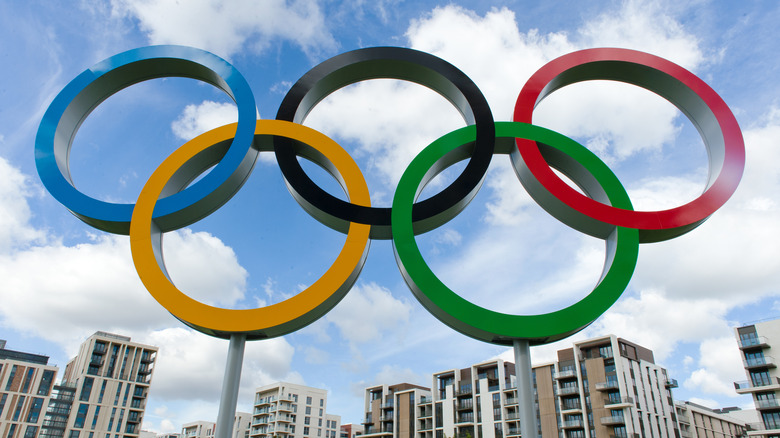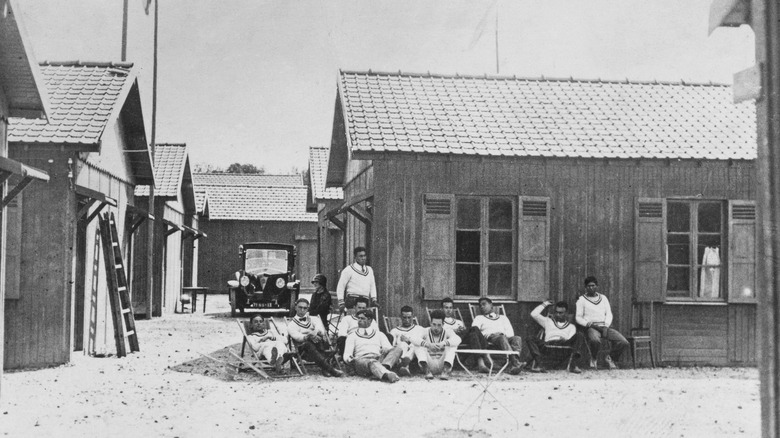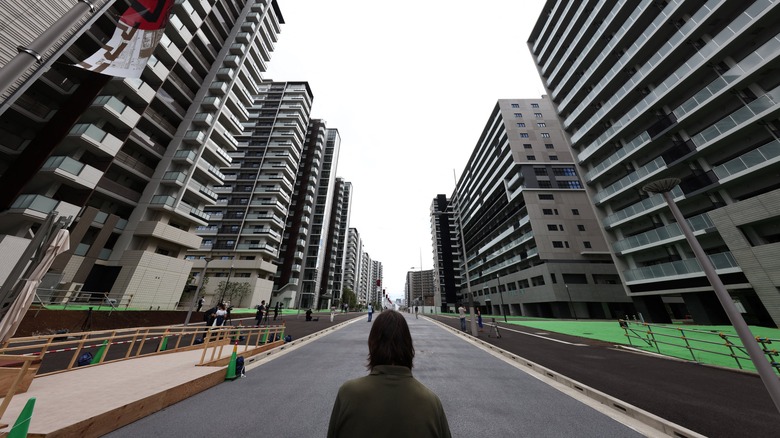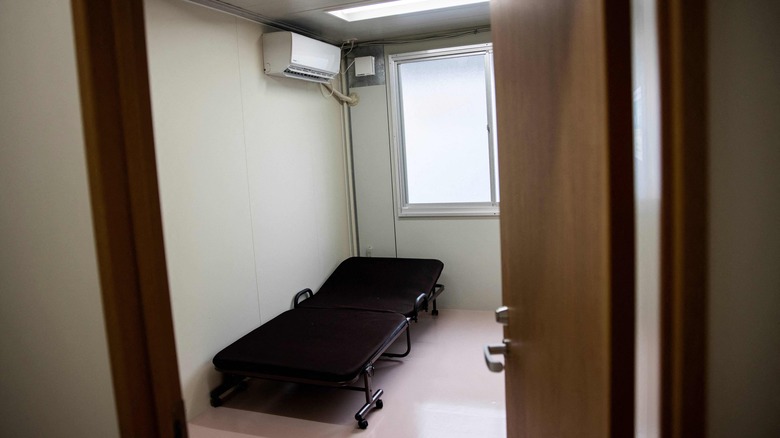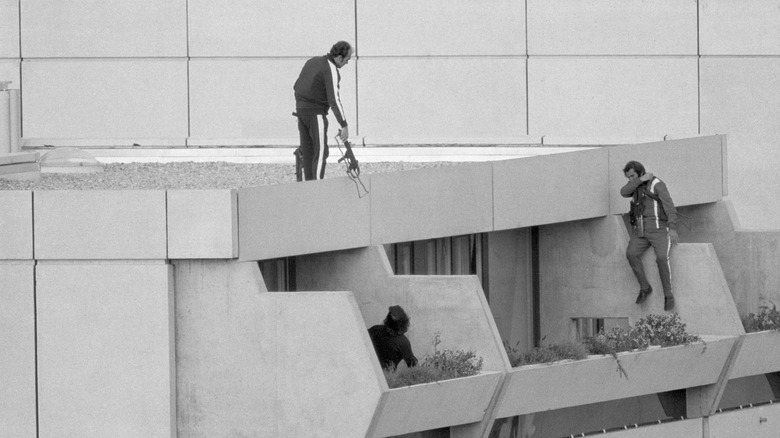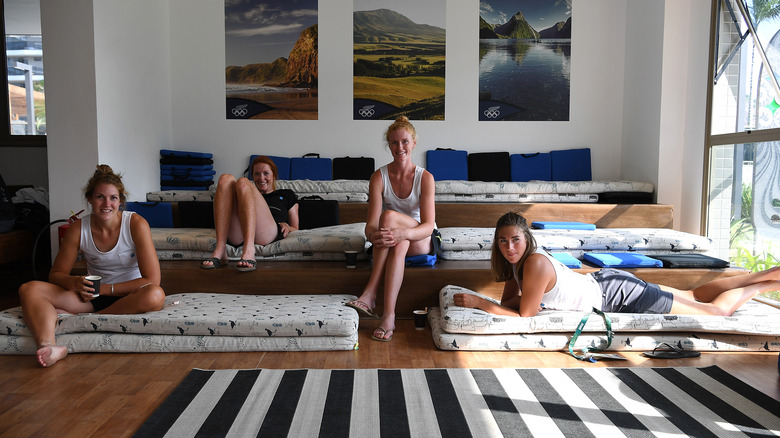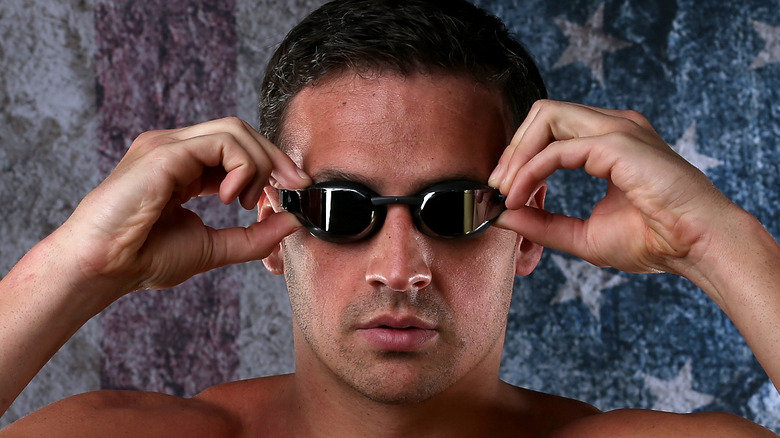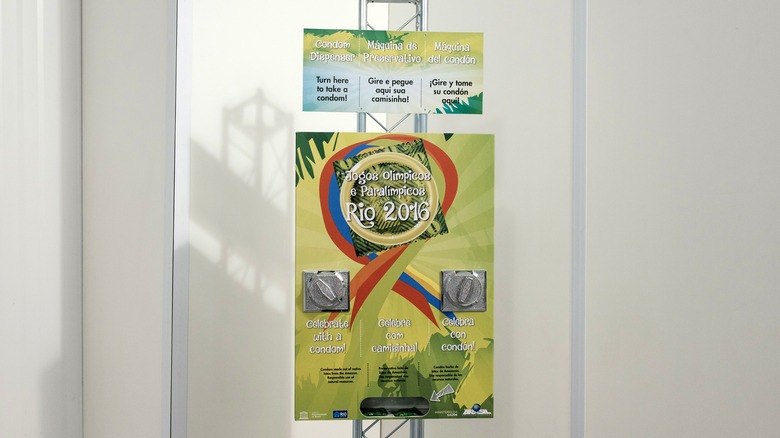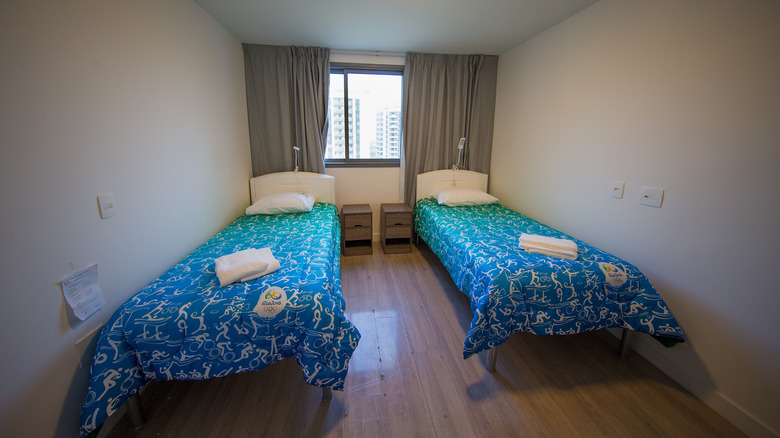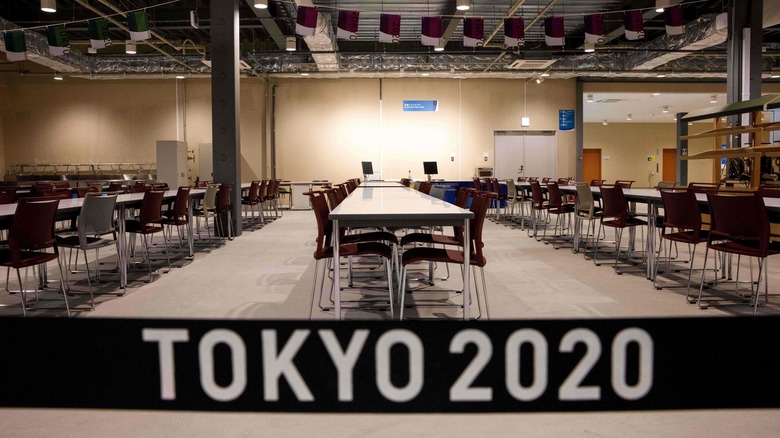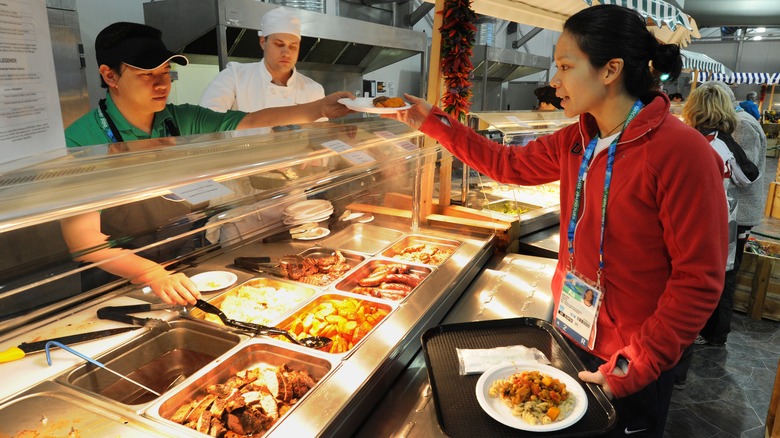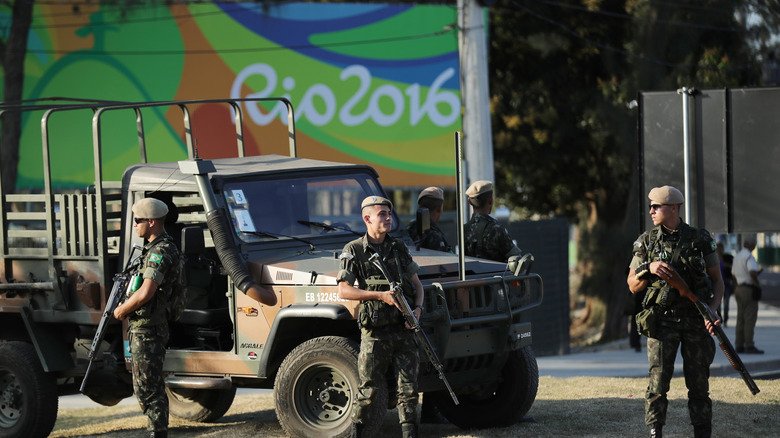The Untold Truth About The Olympic Village
During the Olympics, for a few precious weeks, the world grinds to a halt as people around the globe follow the greatest runners, shooters, wrestlers, javelin-throwers, and many other top-of-the-crop competitors attempting to reach the highest echelons of their respective fields.
The competitions are a pretty big deal, but have you ever wondered where all those professional athletes spend the hours they're not actively trying to become the best of the best? It's not like they spend all their time hanging around the stadium in their sports gear, waiting for the next event to roll around.
When Olympians aren't competing or training, they have to eat, sleep, and generally hang around somewhere. That somewhere is often the Olympic Village, usually a purpose-built complex of buildings where the athletes and their trainers stay during the event. But what is it like in this intentional community? What goes on in this complex might be more curious than some of the actual Olympic events. This is the untold truth about the Olympic Village.
The humble beginnings of the Olympic Village
It's logical that Olympic athletes need accommodation during the event, but the concept of the Olympic Village took some time to find its footing. Though the first modern Olympics took place in Athens, Greece in 1896 (per Britannica), the Guinness World Records gives credit for the first Olympic Village to the Paris Olympics in 1924. The reason for this particular invention was entirely pragmatic, as the hosts deemed it necessary to keep the athletes in the same approximate area near the stadium, instead of having them bunk all over town in various facilities, which had been the custom until these games.
To be fair, though, the 1924 version of the Olympic Village was basically a shantytown of cabins, much less impressive than the huge complexes that would eventually follow. Britannica notes that the first Olympic Village that included dining facilities and other now-staples of Olympic accommodation was seen at the Los Angeles games in 1932.
Modern Olympic Villages are like small cities
To fully understand the concept of the modern Olympic Village, you need to understand the contents of the modern Olympic Village. The sheer scale of these accommodation complexes is mind-boggling, and could reasonably be compared to a tiny city. According to the International Olympic Committee's website, the Olympic Village of the 2018 PyeongChang Winter Olympics was built as two different village complexes — the PyeongChang and Gangneung villages — with a total capacity to host almost 6,800 officials and athletes. During their stay, Olympians don't need to venture away from the premises, except when it's time to compete. Apart from the dining areas and training centers you'd expect, modern Olympic Villages have shops, cultural events such as concerts, and even banks and beauty salons.
Per Associated Press, the village built for the Tokyo 2020 Olympic Games is a grand affair. The massive complex consists of 21 huge tower buildings, with an estimated 18,000 beds for over 11,000 Olympians and 4,400 Paralympians, who will use the facility after the Olympics. The International Olympic Committee tells that the village is located in the seaside Harumi district, so while the huge building blocks may seem somewhat dystopic at a glance, the rooms could have pretty awesome views.
If you're wondering what happens to these massive areas after the Olympics and Paralympics are over, USA Today Travel reports that many of them are repurposed as housing.
The pandemic preparations of the Tokyo 2020 Olympic Village
The Olympic Village for the Tokyo 2020 Olympics has a certain practical aspect that none of its predecessors had to consider: the COVID-19 pandemic. The operation to keep Olympic athletes healthy is, as you'd assume, pretty huge. As the International Olympic Committee tells us, COVID-19 protocols will be observed and enforced by no less than 3,000 COVID-19 Liaison Officers. Per Associated Press, daily tests will be administered to all occupants of the Olympic Village, and if something is awry, they're will stay at the village's custom health clinic area, which bears the mildly ominous name Fever Clinic. There, further tests will determine the patient's condition, and they will either b treated or isolated as the situation requires.
Of course, at the point where they need to start treating people, something has already gone wrong. During the postponed event, there will be a massive focus on control and prevention, and according to ABC News Australia, the authorities have assured the world that the village's safety protocols will be sufficient. An estimated 80% of the Olympic Village residents are fully vaccinated, and they're instructed to avoid interaction in communal spaces like dining areas as much as possible. Mask protocols are also rather strict, and an athlete who trains in the shared fitness center without a face mask could potentially be cut from the competition. Per Inside the Games, athletes can't stick around and watch the rest of the event — they need to leave the village two days after they finish competing.
The Munich Massacre
The Olympics might thought of as a peaceful, unifying event, but at the 1972 Munich Summer Olympics, the bloodier parts of global affairs made their way to the Olympic Village, with tragic results (per History). The Munich games were the first return of the Olympics to Germany since Nazi rule, and they had been dubbed Die Heiteren Spiele (the cheerful games), according to Britannica. But such optimism was ruined on September 4, a week or so into the Olympics, when eight members of a Palestine terrorist group called Black September climbed over the fence of the village, and made their way to a building where Israeli Olympians and officials were staying. They stormed the building, killing two people — wrestling coach Moshe Weinberg and weightlifter Yossef Romano — and collecting nine hostages.
The terrorists demanded the release of a great number of prisoners, but the negotiations ended in a disaster. As the prisoners and the Black September members were transported to a nearby air base as part of an intended exit plan, a woefully ill-prepared German police force ambushed them. The ensuing lengthy confrontation led to the deaths of one police officer, five Black September gunmen, and every single one of the hostages.
The Olympics ground to a halt for a full 24 hours after the shocking event, but ultimately continued after a memorial service.
No reporters and (mostly) no family
For many athletes, the Olympic Village has one very significant perk: It's a rare free zone from overly interested journalists, and also sometimes provides a break from family (per ESPN). Though there are plenty of staff members and security in an Olympic Village (around 13,000 staff were based at the Rio de Janeiro village, according to CTV News), John R. Gold and Margaret M. Gold's book "Olympic Cities" notes that the lack of parents can be a concern, saying that at the 1960 Rome Olympics, the athletes were separated by gender, which "certainly helped allay the fears of the anxious parents of young female athletes."
There are many stories about athletes going wild in the Olympic Village, but as Inside the Games notes, the Tokyo Olympics have barred family members from the village because of the COVID-19 pandemic situation. According to Sports Illustrated, this caused quite an outcry, implying that in normal conditions some family members are permitted. Even the organizers of the 2020 Olympics have made the occasional exception: Athletes who are breastfeeding are allowed to bring their babies along, and, as the Guardian tells us, 13-year-old British skateboarder Sky Brown's father will accompany her to Tokyo.
Things can get steamy in the Olympic Village
In 2012, ESPN ran an article that detailed a hidden but apparently extremely prevalent side of the Olympic Village: A significant percentage of the athletes hook up. "I'd say it's 70 percent to 75 percent of Olympians," swimmer Ryan Lochte is quoted as saying. "Hey, sometimes you gotta do what you gotta do." Alpine skier and Olympics reporter Carrie Sheinberg has confirmed that the amorous atmosphere isn't exclusive to summer Olympic games, either. She compared the Olympic Village to "a magical, fairy-tale place, like Alice in Wonderland, where everything is possible. You could win a gold medal and you can sleep with a really hot guy."
This is not just a bunch of athletes exaggerating their boring lives at the village to mess with journalists. In fact, there are some very telling statistics to back up the Olympic Village's steamy reputation. Per US Magazine, during the weekend when the athletes first entered the 2016 Rio de Janeiro Olympic Village, there was a pretty impressive 129% Tinder usage spike in the area. According to USA Today Sports, the winter athletes at the 2018 PyeongChang Olympics did even better, with a whopping 348% Tinder spike.
The Olympic Village's condom situation is the stuff of legends
As ESPN notes, many athletes have admitted that Olympians tend to hook up with each other rather liberally. This amount of action, of course, requires certain protective measures, and as Time tells us, the Olympics have become quite notorious for the sheer amount of free condoms they distribute to the competitors.
The tradition of free condoms for Olympic Athletes started in the 1988 Seoul Olympics, and three decades later, the 2018 PyeongChang Winter Olympics provided 110,000 condoms to distribute among 2,925 athletes. However, even that impressive amount can't hold a torch to the 2016 Summer Olympics, which took place in Rio de Janeiro and featured 450,000 condoms (per Bustle). Even the relatively socially distanced Tokyo Olympics have risen to the occasion with 160,000 condoms (via the Guardian), though the organizers insist that the athletes should take them home as souvenirs instead of using them on the premises, thank you very much.
As USA Today Sports notes, though, the condoms don't exactly fall from the sky. Instead, the athletes have to go pick them up from a vending machine-style distributor. "You have to turn the thing and it is really loud," equestrian Clarke Johnstone is reported as saying. "I just sort of went in and got a couple and then left, to be honest."
A surprising lack of privacy
The Olympic Village might be a world of its own, but an introverted athlete might be less than thrilled to discover that Olympians don't get to spend too much time by themselves. As ABC News tells us, the general vibe of the village is extremely communal, even though its denizens are largely tucked away from the rest of the world.
"You see how isolated the environment is," psychologist Dr. Judy Kuriansky said of the situation. "They are gated off and you have to have passes to get it. They eat together in large groups. That's why you are psychologically turned to an earlier sense of camp or college. They sleep in these little bunks in suites with common areas. It lends itself to that kind of lifestyle."
This camp vibe very much extends to the athletes' bedrooms, which tend to be less than opulent. As People reports, the athletes' rooms at the 2016 Rio de Janeiro event were pretty sparsely furnished, with single beds and without TVs. Athletes generally have to share their bedrooms with roommates, college dorm-style. The beds have also been known to be too small for some of the larger Olympians, though as CTV News notes, extensions are available.
Despite all the juicy stuff, it's a very professional place
Reports of the Olympic Village's naughty reputation are fairly widespead (via ESPN), but at the end of the day, the people who stay there are still highly trained and motivated athletes who are preparing for what may very well be the most important moments of their entire life. As such, People notes that the athletes generally maintain a laser-like focus as they're waiting for their event, meaning that the general vibe of the Olympic Village is not necessarily party central.
"I think they think it's a lot more glamorous than it is," swimmer Natalie Coughlin is reported as saying of life at the village. "It's really pretty boring. It's like a giant college campus — except that everyone is getting ready for the biggest event of their life, so they're incredibly stressed." She also notes that people have been known to let their hair down after they've done their job, but there's always someone who's still preparing for their competition, so out of discretion, the partying tends to happen out of sight of the competitors who are still trying to maintain their composure.
Sprinter Allyson Felix also feels that the Olympic Village's reputation for debauchery is at least somewhat overpromoted. "Everyone always assumes it's like this big party and this really crazy place, and I think the real thing is it's just a mix of a lot of different people," she is reported as saying.
Olympic Villages have an amazing amount of food
Your body needs fuel to perform, and when you compete at an Olympic level, the amount of food you require is often massive. As Men's Journal tells us, an Olympic athlete might have to consume over 5,000 calories a day, and when thousands of them are gathered in the same place for weeks on end, that means an awful lot of food.
The 2012 London Olympics, for instance, stocked the pantry with 100 tons of beef, 113 tons of seafood and poultry, and a combined 562 tons of fruit, vegetables and potatoes. The athletes at the vast dining halls of the 2016 Rio de Janeiro Olympics tore through 460,000 pounds of delicious food on a daily basis, according to Bon Appetit. Per Food & Wine, the 2018 PyeongChang Olympic Village could whip up anything any athlete could desire from a 18-page menu that was built around six different themes. Britannica reports that each team has a menu prepared in keeping with its own national cuisine.
Allergies and special dietary needs are, of course, taken into account, but interestingly, things aren't always quite as healthy as you'd assume. For instance, pizza is a common feature on the menu. The Washington Post reports that several Olympic Villages have featured a popular (and free) McDonald's, where the Olympians can scratch that Big Mac itch. However, the burger juggernaut has been on the way out, as it stepped away from its Olympics sponsorship contract in 2017.
It's super secure, but not always as safe as you think
When the Olympic Village is operational, it contains thousands of athletes who are, for the duration of the Olympics at least, some of the most visible and famous people in the world. As such, security needs to be pretty heavy. But how heavy is necessary to maintain the happy, peaceful nature of the games? Britannica notes that the Olympics have struggled with this balance in the past. In the 1968 Mexico City Olympics, tensions were high before the games even started, and 10 days before the opening ceremony, armed government forces killed over 200 protesters who were rallying against the Olympics (per Britannica). The 1972 Munchen Olympics, however, went with minimal security, and the combination of bad preparation and light security measures ended in disaster when a terrorist attack left 11 members of the Israeli Olympic team dead.
Fortunately, the Olympics haven't had to endure such tragedy since Munich, but there's still the occasional reminder that keeping the Olympic Village safe and secure is a very careful balancing act, including the deadly bomb at the 1996 Atlanta games. According to the Indian Express, at the 2016 Rio Olympics, the village's security had to be increased rather suddenly after members of the Australian Olympic team were evacuated from a building because of a minor fire, and some of their property was stolen. In response, the organizers reportedly hired a private security force to visibly amp up security measures.
